« Experimenting with dive gear | Main | Watching "The Frogmen" (1951) »
June 15, 2010
Diving the California Channel Islands
When you want to go on a live aboard but don't quite have (or want to spend) the time or money, you can always go on a shorter charter trip. That's what we did when we boarded the good ship Conception in Santa Barbara, taking off for a three day dive trip to the California Channel Islands. What we're talking about here is a chain of eight islands off the coast of Southern California, roughly 15 to 30 miles away from the mainland. Most of the islands are part of a national park and uninhabited except for perhaps a campground or lighthouse. These are tall, rocky islands with a stark, dramatic, albeit not barren, beauty.
We got on the trip through our local dive shop (Fisheye Scuba in Folsom, Calif.) and the cost was remarkably low, probably less than a quarter of what it costs to be on a Caribbean live aboard for a week. No hassling with an airplane trip either. Instead, we packed the car with dive gear and whatever else we thought we might need without ever weighing a bag or agonizing of what to leave behind. We even took our own tanks and weights. Tanks was a bit of an issue because Carol likes to dive Nitrox, and there wasn't any on the Truth Aquatics boats. So we took along three tanks filled with Nitrox, with the intent of Carol using one per day, topping it off with air after each dive. Me, I lugged along my big old low-pressure Steel 95.
The drive down Interstate 5 was uneventful and gave me a chance to check out my latest GPS, a Magellan with a big 7-inch screen. It turned out to be as crotchety and infuriatingly inflexible as most of its predecessors, and was also no help at all in finding our way into and around Santa Barbara's massive marina. Mapping app on the Apple iPad to the rescue. We finally made it, ran into two other couples who were going on the trip, and, since it wasn't time yet to board, walked over to Stearns Wharf, a massive wooden pier jutting out many hundreds of feet into the ocean. Here we learned a bit about Channel Island cruising basics from our new friends.
These boats are considerably smaller than your average full-size live aboard, but still large enough for dozens of divers (or kayakers or fishermen or anyone else). There aren't individual staterooms, but single and double bunks in the bottom of the boat. The Conception is about 80 feet long (as compared to 110 to 130 feet for most Caribbean live aboards).
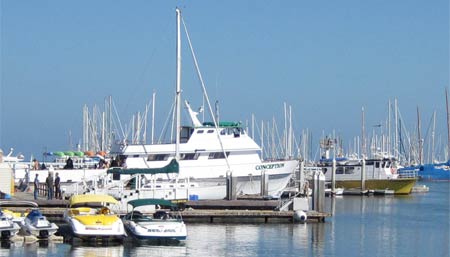
After an early dinner at a pizza place, the Conception was ready to board. Boarding meant hauling all our gear from the marina parking in rickedy push carts and then hefting it all on and below deck. No crew waiting here to help like on the big live aboards; it's all self-service. In fact, we didn't see the crew until later and relied on tips from experienced Channel Island travelers instead to find our way around. The bunks below deck at first looked claustrophobic, without any place to stow away stuff, but since the boat wasn't full we had space to spread out a bit and it actually turned out to be a nice and cozy experience. The bunks came with mattresses, pillows and blankets, but travelers brought along their own sheets and bedding (or sleeping bags).

Looking around revealed a bathroom section with sinks and two large showers, three toilets up on the main deck, a large dive deck where we set up our dive gear, a large dining/hangout room on the main deck, and upstairs the wheel house with space to enjoy the view. We signed the requisite waivers, then settled for the night (but not before taking a Bonine and some ginger against potential sea sickness).
The Conception left Santa Barbara sometime during the night and the seas were rather choppy. I was quite aware of it, but apparently never really woke up as when I did open my eyes, we were already there, there being Santa Cruz island, the largest of the northern islands. It's almost a hundred square miles or so of rock, jutting out of the ocean in ragged peaks and soaring to almost 2,500 feet at its highest point at Devils Peak. The boat was milling back and forth, something we'd come to experience many more times over the three days of the trip as the captain was either trying to find a good or better spot, or getting the anchor to bite.
The crew introduced themselves, there being a captain and assistant captain, two deckhands/dive masters, and Jill, the cook. We learned the law of the land, covering the basics of safety, use of bathrooms, food, diving, schedule and the weather situation. Unlike on "full" live aboards, everyone's on their own for diving. A safety diver is standing by, all suited up and ready to go, but there aren't any dive masters guiding the dives. Tanks would be refilled after each dive from the ship's compressors, the crew would hand you cameras when you went in, assisted in getting back on the boat, and meticulously kept track of all divers, but no more than that.
Our first dive was at a dive site called Frys, close to the shore (as all dives would be) and with plenty of kelp. The water wasn't quite as cold as the captain had said it might be, but still a chilly 56 degrees. I was wearing a 5mm shorty with hood over my 7mm wetsuit, and that made the cold water bearable, though hands and feet got cold quickly. All of our group wore wetsuits, other guests wore dry suits, mostly DUI.
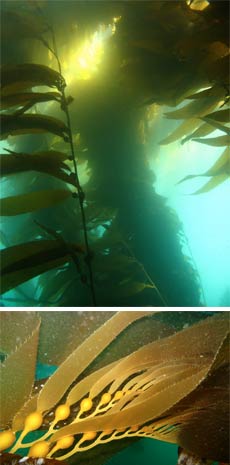 Visibility was marginal, perhaps 20 feet or so. This meant descending along the anchor line until we hit bottom close to the shore. There was a good deal of kelp, making for a magical underwater forest. Kelp is probably something that's impossible to describe to non-divers. It looks just like ugly seaweed floating on the surface. Underwater it's graceful, beautiful strands and leafy structures streaming up from the sea bottom like magical trees. It's beautiful to see and swim through, and though divers may occasionally get snagged a bit, it's no problem at all to swim through the forests and around individual plants.
Visibility was marginal, perhaps 20 feet or so. This meant descending along the anchor line until we hit bottom close to the shore. There was a good deal of kelp, making for a magical underwater forest. Kelp is probably something that's impossible to describe to non-divers. It looks just like ugly seaweed floating on the surface. Underwater it's graceful, beautiful strands and leafy structures streaming up from the sea bottom like magical trees. It's beautiful to see and swim through, and though divers may occasionally get snagged a bit, it's no problem at all to swim through the forests and around individual plants.
We didn't see a lot of fish, though on those first two dives at Frys we encountered both a Horn Shark and a Swell Shark, both smallish sharks that like to hang out in rocky reefs and kelp beds. We also saw a sea hare, a huge variety of different star fish, some colorful nudibranchs, and a trillion urchins, both of the large black variety and the smaller blue kind. One type of fish was abundant: sardines. They swam around us in huge schools, a silvery dance of little fish, darting and weaving in unison.
Orientation was difficult due to the poor visibility, and so it was good that we were always close to the shore and the boat, and in fairly shallow water. In fact, all dives were in just between 30 and 50 feet, but without being able to see, it might as well have been a hundred. As is, staying shallow meant more light, whatever there was, and also never having to worry about running low on air. In fact, I never came close to using up my big 95-cubic foot tank.
We ended up skipping the two afternoon dives as the visibility was only getting worse and it was quite cold. The dry suit divers, of course, went, but their reports afterwards showed that we hadn't missed anything. No night dive either; the conditions just weren't there.
Dinner was a treat. Cook Jill barbecued massive slabs of tri-tip steaks on the Conception's outdoor grill. The food was terrific for the whole trip, with breakfast made to order for each diver, ample sweets and snacks between meals, fresh salads, and enough variety and accommodation of special requests to satisfy everyone onboard. For dessert there were strawberries, cheesecake, ice cream and cake.
Had anyone told me I'd have perhaps the best few nights' sleep in a long while, I would not have believed them. Yet, I slept like a baby in our bunk in the bowels of the gently rocking Conception, and also slept more and longer than I usually do. And that was not out of boredom, but just the pleasant exhaustion from diving and being on the sea.
While the weather wasn't bad and we had sun during most of our trip, including a breathtaking sunset, the captain had to hustle to keep us in reasonably calm waters with a degree of visibility and free of current. So on the second day we moved on to Anacapa, the smallest of the northern islands. It's just a square mile or so of rock with a lighthouse and dramatic arcs and peaks. Anacapa, too, soars up to almost a thousand feet straight out of the sea, making it perfect for birds of all kinds.
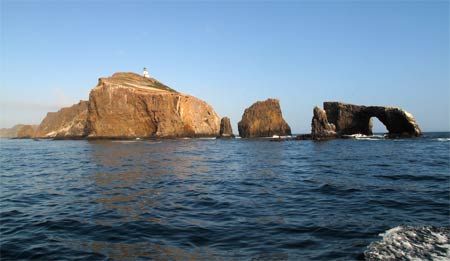
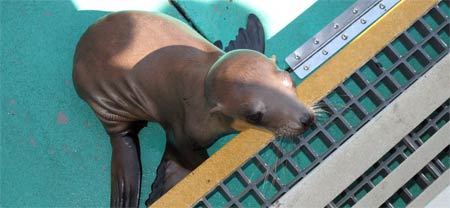
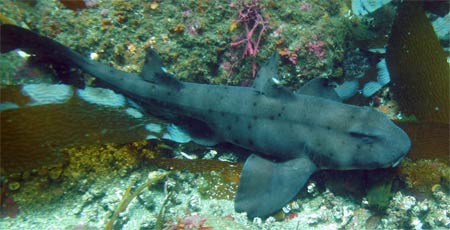
And also for sea lions. Our first dive was at The Rookery, named after the small colonies of sea lions inhabiting the narrow strips of sand in the numerous small coves. Turns out the current was quite a bit more than expected, and so we never let go of the anchor line until we hit the rocky reef close to shore at no more than 25 feet or so. Even that provided little sanctuary from the ripping current and so, after a brief excursion in search of calmer waters, I returned to the anchor line and hung on, taking a close-up look at all the urchins, stars, garibaldis and plantlife there. At times, sea lions appeared out of nowhere, darting around us with almost impossible speed and grace. It was a short dive, though, and after no more than 35 minutes or so we had pulled ourselves back to the boat. The crew had actually deployed a long surge line so that divers blown away by the current could swim to it and pull themselves back to the boat. Amazingly, no one lost their way and no one had gotten blown off-course.
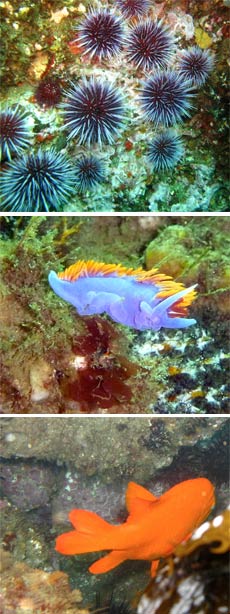 After a good deal of hunting and searching, the Conception anchored at another Anacapa dive spot, this one called The Aquarium. Visibility was no better (around 20 feet), but at least there was no current and so we explored the sandy bottom with kelp and rocks at around 40 feet. You can find all sorts of interesting critters on kelp and that's what we did. This would have been a spectacular site had we only had a bit more viz. As is, we moved on to The Bat Cave instead.
After a good deal of hunting and searching, the Conception anchored at another Anacapa dive spot, this one called The Aquarium. Visibility was no better (around 20 feet), but at least there was no current and so we explored the sandy bottom with kelp and rocks at around 40 feet. You can find all sorts of interesting critters on kelp and that's what we did. This would have been a spectacular site had we only had a bit more viz. As is, we moved on to The Bat Cave instead.
Here we were, once again, close to the impressive rocks that drop almost vertically into the sea, forming small coves and shallow caves. We followed the anchor line through thick beds of kelp, enjoying the swaying of the plants with its many colors and dancing lights. Close to the rock we got into heavy surge moving and heaving us back and forth through an almost exotic wealth of kelp and plants. The surge got to be a bit much and so we headed away from the cliffs into deeper water, weaving through kelp and rock in what was by far my most favorite dive of the trip. We took pictures and shot video and enjoyed ourselves despite the still cold water (low 60s).
After another great night's sleep in the bunk (and an evening spotting humpback whales), the Conception returned to Santa Cruz island and finally dropped anchor at the Scorpion Anchorage where there are two spires jutting out of the water. They're simply named Rock 1 and Rock 2, peeking out of the water by no more than 15 or 20 feet. Here we saw a couple of other boats,a pier, and some structures on land -- apparently part of a ranger station and a campground. They'd even planted palm trees.
Diving Rock 1 once again meant following the anchor line in murky viz, and then diving around the rock, which broke out of a sandy bottom at perhaps 30 feet. Thanks to varied rock formations and plentiful sealife, this was a lot more fun than it sounds. We circled the pinnacle three times or so, each time finding new things to watch and photograph, then used the compass to head back for the boat. We passed on Rock 2 and had already started packing our gear when the captain, perhaps making up for the missed night dives, stopped over the wreck of a World War II mine sweeper. The dry suit guys all went in, and most found the wreck that apparently was remarkably well preserved, with most of the metal parts still intact.
After a smooth crossing of the Santa Barbara Channel, which I spent dozing in my bunk, we were back in the marina by 5 o'clock or so. That was the end of a truly enjoyable trip with interesting diving, great camaraderie, terrific food, and a friendly, helpful crew. We'll be back for sure.
Posted by conradb212 at June 15, 2010 2:37 PM








